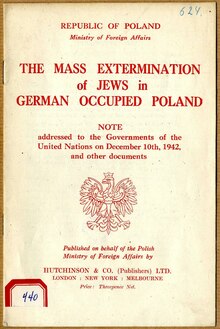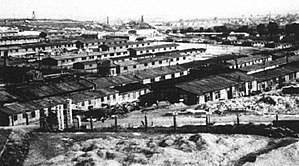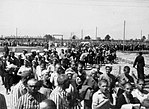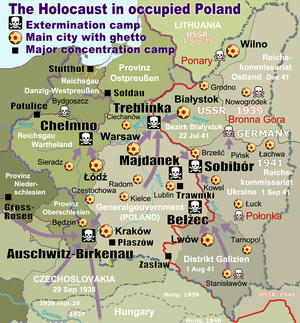German camps in occupied Poland during World War II
| Left to right (top to bottom): Concentration camp in Płaszów near Kraków, built by Nazi Germany in 1942 • Inmates of Birkenau returning to barracks, 1944 • Slave labour for the Generalplan Ost, making Lebensraum latifundia • Majdanek concentration camp (June 24, 1944) • Death gate at Stutthof concentration camp • Map of Nazi extermination camps in occupied Poland, marked with white skulls in black squares | |
| Operation | |
|---|---|
| Period | September 1939 – April 1945 |
| Location | Occupied Poland |
| Prisoners | |
| Total | 5 million Polish slave labour [1] |
| Dead victims | 6,000,000 Poles and Polish Jews |
The German camps in occupied Poland during World War II were built by Nazi Germany in the course of its occupation of Poland (1939–1945) both in the areas annexed by Germany, and in the territory of General Government formed by the Third Reich in the middle. A system of camps of various kinds was established across the entire country, including extermination camps, Nazi concentration camps, forced labour, and POW camps.
German-occupied Poland was a prison-like territory. It contained 457 camp complexes. Some of the major ones, such as Auschwitz, Gross-Rosen, and Stutthof, consisted of dozens of subsidiary camps scattered over a broad area. At Gross-Rosen (to which Polish nationals were expelled from the annexed part of Poland) the number of subcamps was ninety seven (97).[2] Under Auschwitz I, Auschwitz II Birkenau, and Auschwitz III (Monowitz) the number was forty-eight (48), with thousands of prisoners each; their detailed description of purpose is provided by the Auschwitz-Birkenau State Museum.[3][4] Stutthof had forty (40) subcamps officially and as many as 105 subcamps in operation,[5] some as far as Elbląg, Bydgoszcz and Toruń, at a distance of 200 kilometres (120 mi) from the main camp.[6][7]
Overview
The camp system was one of the fundamental institutions of the Nazi regime, and with the invasion of Poland became the backbone of German war economy and the state organized terror. It is estimated that some 5 million Polish citizens went through them.[1] The racist policies of the Third Reich against Slavs and other "undesirables" filled the labor and concentration camps from the first days of occupation. The deliberate maltreatment, starvation, overwork and executions of prisoners amounted to the largest ethnic cleansing in European history.[1]
Between 1941–1942, the concerted effort to destroy the Polish Jews including those of other European nationalities led to the creation of death camps, constructed for the sole purpose of extermination. It was only after the majority of Jews from all Nazi ghettos were annihilated that the gas chambers and crematoria were blown up in a systematic attempt to hide the evidence of the crimes. The Nazi Germans turned Auschwitz Konzentrationslager into a major death camp by expanding its extermination facilities. The cremation ovens working around the clock till November 25, 1944; were blown up by the orders of SS chief Heinrich Himmler himself.[4][8]
Extermination camps
The German Nazi government established extermination camps (Vernichtungslager) in Poland after the Final Solution policy was formulated at the Wannsee Conference near Berlin in January 1942. The killing facilities of secretive Operation Reinhard were added to already functioning extermination through labor systems, including at Auschwitz and Majdanek; both operating in a dual capacity until the end of the war. In total, the Nazi German death factories (Vernichtungs- oder Todeslager) designed to systematically kill trainloads of people by gassing, under the guise of a shower, included the following:
German extermination camps in Poland Vernichtungslager Nazi-delineated territory Polish location Holocaust victims 1 Auschwitz-Birkenau Oberschlesien Oświęcim near Kraków 1.1 million, around 90 percent Jewish.[9] 2 Treblinka * Generalgouvernement 80 km north-east of Warsaw 800,000–900,000 at Camp II (and 20,000 at Camp I).[10] 3 Belzec * Generalgouvernement Bełżec near Tomaszów Lubelski 600,000 with 246,922 from General Government.[11]
4 Sobibor * Generalgouvernement 85 km south of Brześć nad Bugiem 200,000 (140,000 from Lublin and 25,000 from Lwów).[12] 5 Chełmno Reichsgau Wartheland 50 km north of Łódź 200,000 (most via the Łódź Ghetto).[13] 6 Majdanek Generalgouvernement Lublin city district at present 130,000 per Majdanek State Museum research.[14] *) Killing factories of secretive Operation Reinhard, 1942–43
The primary function of death camps was the elimination of Jews from all countries occupied by Germany, except the Soviet Union (Soviet Jews were generally killed on the spot). Many non-Jewish Poles and other prisoners were also murdered in these camps; an estimated 75,000 non-Jewish Poles died at Auschwitz-Birkenau and up to 200,000 at KL Warschau. Most extermination camps had regular concentration camps set up along with them including Auschwitz-Birkenau, Majdanek, Treblinka I and Warsaw. However, these camps were distinct from the adjoining extermination camps.[15]
Concentration camps
Before September 1939, the concentration camps in Germany held mainly Jews and political enemies of the Nazi regime,[4] but everything changed dramatically with the onset of World War II. The Nazi concentration camps set up in German-occupied Europe (Konzentrationslager, KL or KZ) were redesigned to exploit the labor of foreign captives and prisoners of war at high mortality rate for maximum profit. Millions of ordinary people were enslaved as part of the German war effort. The Jewish Virtual Library estimates that the number of camps reached 15,000 eventually, using civilians arrested and ambushed at random in occupied territories. The majority of prisoners perished due to starvation diet, exhaustion, disease and regular executions.[16]
Many concentration camps, as well as Jewish ghettos,[17] set up in German occupied Poland during the Holocaust served as transit points to the extermination camps. As far as forced labour, there was little difference between them except for punitive actions. Some camps were built so that the prisoners could be worked to death out of the public eye; this policy was called Vernichtung durch Arbeit (annihilation through work). Large numbers of non-Jewish Poles were also imprisoned in these camps, as were various prisoners from other countries. For example, at the beginning of war, the Stutthof concentration camp near Gdańsk served exclusively for the extermination of Polish elites, but before long, it became a nightmare of Moloch with 105 subcamps extending as far as 200 kilometers south into the heartland of Poland and more than 60,000 dead before the war's end, mainly non-Jewish Poles.[5] Among the major concentration camps run by SS in the country for the purpose of willful killing of forced laborers, the most notable examples included Warsaw concentration camp in the capital, the Soldau concentration camp in Działdowo, and the Kraków-Płaszów concentration camp made famous in the feature film Schindler's List and the Inheritance documentary.[18]
The Gross-Rosen concentration camp located in Rogoźnica, Poland (part of the German Silesia in World War II),[19] was surrounded by a network of 97 satellite camps (Aussenlager) populated with Polish nationals expelled from Wartheland in the process of ethnic cleansing. By October 1943, most inmates were Polish Jews spared from gas chambers, including nearly 26,000 women. The prisoners were put to work for German state projects of Organization Schmelt,[20] and for the war profiteering companies such as Blaupunkt, Siemens, Krupp, IG Farben, and Daimler-Benz among others.[21] There were similar concentration camps at Budzyń, Janowska, Poniatowa, Skarżysko-Kamienna, Starachowice, Trawniki and Zasław.[22]
Labor camp categories

The Germans pressed large numbers of Poles and Polish Jews into forced labour. The labourers, imprisoned in German Arbeitslager camps and subcamps across Poland and the Reich, worked for a broad range of war-related industries from armaments production and electronics to army uniforms and garments.[21] At most camps, including Buchenwald, the Poles and Polish Jews deported from Pomerania and Silesia were denied recognition as Polish nationals.[23] Their true numbers can never be known. Only 35,000 Poles who were still alive in 1945 came back to Poland and registered as Buchenwald survivors, others remained in the West.[23]
The Gross-Rosen population accounted for 11% of the total number of inmates in Nazi concentration camps by 1944,[24] and yet by 1945 nothing remained of it due to death march evacuation.[20] Auschwitz run about 50 subcamps with 130,000-140,000 Poles on record, used as slave labour. Over half of them perished there; others were shipped to other complexes.[25] There were hundreds of Arbeitslager camps in operation, where at least 1.5 million Poles performed hard labour at any given time. Many of the subcamps were transient in nature, being opened and closed according to the labour needs of the occupier. There were also around 30 Polenlager camps among them, formally identified in Silesia as permanent (see list)[26] such as Gorzyce and Gorzyczki.[27] Many of the 400,000 Polish prisoners of war captured by Germans during the 1939 invasion of Poland were also imprisoned in these camps, although many of them were sent as forced labourers to the heartland of Germany. Several types of labor camps in this category were distinguished by German bureaucracy.[28]
- Arbeitslager was general-purpose term for labor camps in the direct sense.
- Gemeinschaftslager was a work camp for civilians.
- Arbeitserziehungslager were training labor camps, where the inmates were held for several weeks.
- Strafarbeitslager were punitive labor camps, originally created as such, as well as based on prisons.
- The term Zwangsarbeitslager is translated as forced labor camp.
- Polen Jugenverwahrlag were set up for Polish children hard to Germanize.
- Volksdeutsche Mittelstelle camps for the actual, and the presumed ethnic Germans.
Prisoner of war camps
The Germans established several camps for prisoners of war (POWs) from the western Allied countries in territory which before 1939 had been part of Poland. There was a major POW camp at Toruń (Thorn) and another at Łódź, plus a number of smaller ones. Many prisoners of war from the Soviet Union were also brought to Poland, where most of them died in labor camps. The Germans did not recognise Soviets as POWs and several million of them died in German hands. They were fed only once a day, and the meal would consist of bread, margarine and soup.
The victims

The Polish nation lost the largest portion of its pre-war population during World War II. Out of Poland's pre-war population of 34,849,000, about 6,000,000 - constituting 17% of its total - perished during the German occupation. There were 240,000 military deaths, 3,000,000 Polish-Jewish Holocaust victims, and 2,760,000 civilian deaths (see World War II casualties backed with real research and citations).
The Polish government has issued a number of decrees, periodically updated, providing for the surviving Polish victims of wartime (and post-war) repression, and has produced lists of the various camps where Poles (defined both as citizens of Poland regardless of ethnicity, and persons of Polish ethnicity of other citizenship) were detained either by the Germans or by the Soviets.
Camps after the liberation
German camps were liberated by the Red Army and Polish Army in 1944 or 1945. A number of camps were subsequently used by the Soviets or Polish communist regime as POW or labor camps for Germans, Poles, Ukrainians, e.g.: Zgoda labour camp, Central Labour Camp Potulice, Łambinowice camp.[29]
Decrees of Polish Parliament
On 20 September 2001 the Sejm of the Republic of Poland introduced a special bill devoted to commemoration of Poland's citizens subjected to forced labour under German rule during World War II. The bill confirmed various categories of camp victims as defined during the founding of the Institute of National Remembrance (Dz.U.97.141.943),[30] but most importantly, named every Nazi German concentration camp and subcamp with Polish nationals in them. The list was compiled for legal purposes as reference for survivors seeking international recognition and/or compensation action. It included Soviet and Stalinist places of detention as well. Among the Nazi German camps were 23 main camps with Polish prisoners, including 49 subcamps of Auschwitz, 140 subcamps of Buchenwald, 94 subcamps of KZ Dachau, 83 subcamps of KZ Flossenbürg, 97 subcamps of Gross-Rosen, 54 subcamps of KZ Mauthausen, 55 subcamps of Natzweiler, 67 subcamps of KZ Neuengamme, 26 subcamps of Ravensbrück, 55 subcamps of KZ Sachsenhausen, 28 subcamps of Stutthof, 24 subcamps of Mittelbau and others. Without exception, they were set up by the Germans for the abuse and exploitation of foreign nationals.[19]
See also
- History of Poland (1939-1945)
- The Holocaust in Poland
- Łapanka
- Potulice concentration camp
- Nazi crimes against ethnic Poles
- Operation Tannenberg
Notes and references
- ^ a b c Dr Waldemar Grabowski, IPN Centrala (2009-08-31). "Straty ludności cywilnej". Straty ludzkie poniesione przez Polskę w latach 1939-1945. Bibula – pismo niezalezne. Retrieved February 20, 2013.
Według ustaleń Czesława Łuczaka, do wszelkiego rodzaju obozów odosobnienia deportowano ponad 5 mln obywateli polskich (łącznie z Żydami i Cyganami). Z liczby tej zginęło ponad 3 miliony.
- ^ "Filie obozu Gross-Rosen". Gross-Rosen Museum (Muzeum Gross Rosen w Rogoźnicy). Retrieved 15 May 2015.
{{cite web}}: Italic or bold markup not allowed in:|publisher=(help); Unknown parameter|trans_title=ignored (|trans-title=suggested) (help) - ^ List of Subcamps of KL Auschwitz (Podobozy KL Auschwitz). The Auschwitz-Birkenau State Museum in Oświęcim, Poland (Państwowe Muzeum Auschwitz-Birkenau w Oświęcimiu), 1999-2010 Template:Pl icon
- ^ a b c Compiled by Dr. S.D. Stein (2000). "Background and Introduction: German Crimes in Poland, Central Commission for Investigation of German Crimes in Poland. Volume I, Warsaw 1946". Howard Fertig, New York, 1982.
Summary Details of Main Concentration, Slave Labour and Extermination Camps.
{{cite web}}: External link in|quote= - ^ a b Holocaust Encyclopedia (20 June 2014). "Stutthof". United States Holocaust Memorial Museum. Retrieved 17 May 2015.
- ^ "Forgotten Camps: Stutthof". JewishGen. Retrieved 15 May 2015.
- ^ "Stutthof (Sztutowo): Full Listing of Camps, Poland" (Introduction). Jewish Virtual Library. Retrieved 15 May 2015.
Source: "Atlas of the Holocaust" by Martin Gilbert (1982).
{{cite web}}: External link in|format= - ^ Auschwitz-Birkenau State Museum in Oświęcim, Poland. 13 September 2005, Internet Archive.
- ^ Data sources: Rees, Laurence (2005). Auschwitz: A New History. New York: Public Affairs. ISBN 1-58648-303-X, p. 298. Snyder, Timothy (2010). Bloodlands: Europe Between Hitler and Stalin. New York: Basic Books. ISBN 978-0-465-00239-9, p. 383.
- ^ Holocaust Encyclopedia, Template:Wayback. United States Holocaust Memorial Museum.
- ^ Jacek Małczyński (2009-01-19). "Drzewa "żywe pomniki" w Muzeum – Miejscu Pamięci w Bełżcu (Trees as living monuments at Bełżec)". Współczesna przeszłość, 125-140, Poznań 2009. University of Wrocław: 39–46. Retrieved 19 May 2015.
- ^ Raul Hilberg (1985), The Destruction of the European Jews by Yale University Press, p. 1219. ISBN 978-0-300-09557-9.
- ^ MOZKC (28 December 2013). "Historia obozu (Camp history)" (Information for visitors). Chełmno extermination camp. Muzeum Kulmhof w Chełmnie nad Nerem. Retrieved 19 May 2015.
- ^ Paweł Reszka (Dec 23, 2005). "Majdanek Victims Enumerated. Changes in the history textbooks?" (Internet Archive). Gazeta Wyborcza. Auschwitz-Birkenau State Museum. Retrieved April 29, 2013.
- ^ Moshe Lifshitz, "Zionism". (ציונות), p. 304; (in) Trapped in a Nightmare by Cecylia Ziobro Thibault, ISBN 1938908430.
- ^ Jewish Virtual Library, Concentration Camp Listing. Sourced from Van Eck, Ludo Le livre des Camps. Belgium: Editions Kritak; and Gilbert, Martin Atlas of the Holocaust. New York: William Morrow 1993 ISBN 0-688-12364-3. Published are the names of 149 main camps and 814 subcamps, organized by country.
- ^ Template:Wayback. Pamięć Miejsca. Retrieved 20 May 2015.
- ^ "30th Annual News & Documentary Emmy Awards Winners Announced at New York City Gala" (PDF file, direct download 50.4 KB). National Academy of Television Arts & Sciences. Retrieved 20 May 2015.
- ^ a b Rozporządzenie Prezesa Rady Ministrów (29 September 2001). "W sprawie określenia miejsc odosobnienia, w których były osadzone osoby narodowości polskiej lub obywatele polscy innych narodowości" (Internet Archive). Dz. U. z dnia 29 września 2001 r. Dziennik Ustaw, 2001. Nr 106, poz. 1154. Retrieved 19 May 2015.
- ^ a b Dr Tomasz Andrzejewski, Dyrektor Muzeum Miejskiego w Nowej Soli (8 January 2010), 'Organizacja Schmelt.' Marsz śmierci z Neusalz (Internet Archive). Skradziona pamięć! Tygodnik Krąg. Retrieved 22 May 2015.
- ^ a b Holocaust Encyclopedia (2014), The Gross-Rosen concentration camp (Internet Archive). United States Holocaust Memorial Museum. Retrieved 22 May 2015.
- ^ "Forced labor-camps in District Lublin: Budzyn, Trawniki, Poniatowa, Krasnik, Pulawy, Airstrip and Lipowa camps". Holocaust Encyclopedia: Lublin/Majdanek Concentration Camp. United States Holocaust Memorial Museum. Retrieved April 19, 2013.
- ^ a b Dr Bohdan Urbankowski (2010). "W cieniu Buchenwaldu (In the deep shadow of Buchenwald)". Pamięć za drutami. Magazine Tradycja, pismo społeczno-kulturalne. ISSN 1428-5363. Retrieved 20 May 2015.
{{cite web}}: Italic or bold markup not allowed in:|publisher=(help) - ^ "Historia KL Gross-Rosen". Internet Archive (in Polish). Muzeum Gross Rosen w Rogoźnicy. Retrieved 20 May 2015.
- ^ Auschwitz Museum (2015). "Różne grupy więźniów. Polacy". KL Auschwitz. Państwowe Muzeum Auschwitz-Birkenau. Retrieved 22 May 2015.
- ^ FPNP database. "Lista Polenlagrów" (PDF 251 KB). Obozy przesiedleńcze i przejściowe na terenach wcielonych do III Rzeszy. Demart. p. 6. Retrieved May 14, 2012.
- ^ Das Bundesarchiv. "Directory of Places of Detention". Federal Archives. Retrieved May 11, 2012.
Search keyword: Polenlager
{{cite web}}: Italic or bold markup not allowed in:|publisher=(help) - ^ War relics (2013). "List of some of the more common terms and abbreviations". SS Dienstalterliste. Internet Archive. Retrieved 29 May 2015.
- ^ "One place, different memories". Geschichtswerkstatt Europa. 2010. Retrieved August 12, 2015.
- ^ Sejm Rzeczypospolitej Polskiej (24 January 1991). "Ustawa z dnia 24 stycznia 1991 r. o kombatantach oraz niektórych osobach będących ofiarami represji wojennych i okresu powojennego" (Internet Archive). Dz. U. z dnia 24 stycznia 1991 r. Dziennik Ustaw, 1997. Nr 142, poz. 950. Retrieved 19 May 2015.
- Template:Wayback
- Polish Council of Ministers Template:Wayback
- German Camps Polish Victims, The German occupation of Poland. Compendium of anti-Polish sentiment by PMI group; Cardiff, Wales.






